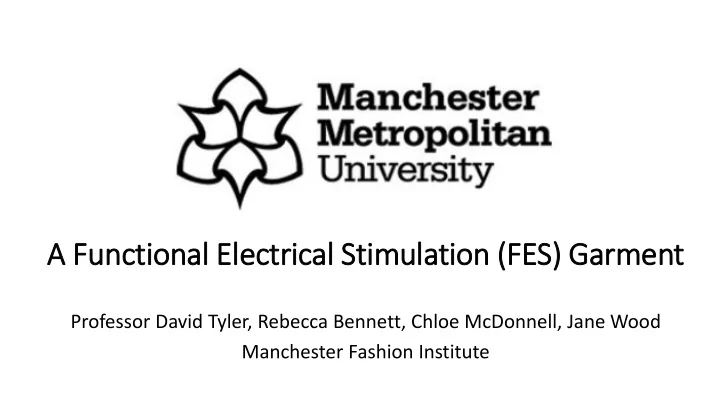

A Functional Electrical Stimulation (F (FES) Garment Professor David Tyler, Rebecca Bennett, Chloe McDonnell, Jane Wood Manchester Fashion Institute
Aim • Develop a fully textile garment with dry electrodes (alternative to hydrogel electrodes) • Screen printed, heat transfer electrode can be designed to any size and shape applicable to end use.
Purpose: Workin ing wit ith patie ients wit ith spin inal cord in inju jury ry • After injury, increased risk of low bone mineral density (osteoporosis) • Increased risk of fracture • Lengthy hospital stays – possible increase in mortality risk
Purpose: Workin ing wit ith patie ients wit ith spin inal cord in inju jury ry • Bone adaptation achieved through weight bearing exercise • Functional electrical stimulation (FES) – controlled movement in people with paralysis • Electrodes target muscle fibres • Controlled movements
Purpose: Workin ing wit ith patie ients wit ith spin inal cord in inju jury ry • Electrodes currently ‘strapped’ to patient • Is there a way of incorporating these into a garment? • Textile electrodes have extended lifetime vs hydrogel
Materials • Screen printed electrode • Synthetic / elastane • Zip • Velcro • Metal press stud
Methods • Tests on able-bodied participant to measure torque and pain threshold • Position of electrodes based on standard location used by practitioners. • Tested using hydrogel electrodes. • Repeated using dry electrodes (screen printed and heat transferred onto garment)
Methods • 30Hz square wave pulses at 10mA intervals generated for 2 seconds • Each step increased by 10mA up to 60mA • Torque measurement taken at each step. • Results compared
Findings • Velcro provided easiest donning / doffing solution • Compression had no beneficial effect on resistance of electrode, though comfort was noted by user. • Ease of electrode positioning
Findings • Dry electrode was activated at 10mA higher than the hydrogel electrode . • Equal results to 60mA • Repeats at 60mA resulted in large jump in torque
Conclusion • ‘ Garment’ design is suitable - facilitates easy donning/doffing - adequate compression • Screen -printed electrodes - Jump in torque for 60mA unclear and remains to be investigated • Future work will examine dry and wet state, extension and recovery of electrodes
The Future • Explore potential wider physiotherapy applications • Home use? • Activity stimulation for those less mobile • Possible incorporation into garments to apply to different muscle groups
Questions?
Contact Rebecca Bennett: Rebecca.bennett@mmu.ac.uk Chloe McDonnell: C.McDonnell@mmu.ac.uk Professor David Tyler: D.Tyler@mmu.ac.uk Jane Wood: J.E.Wood@mmu.ac.uk
Recommend
More recommend